Abstract
Sera from three patients with systemic lupus erythematosus, hereditary angioneurotic oedema and erythema exudativum multiforme, respectively, have been investigated for total complement (C'), complement components (C'1, C'2, C'3, C'4), including β1C-globulin, as well as inhibitory and enzymatic substances which are capable of inactivating C' components. All three sera had a low total C' activity. The serum from the patient with systemic lupus erythematosus had low levels of C'4, C'2 and β1C-globulin, and the reduction of total C' could possibly be attributed to an antigen–antibody reaction in vivo. It is known that the low total C' activity and the pronounced lowering of C'1, C'4 and C'2 in serum from patients with hereditary angioneurotic oedema is due to the enzymatic inactivation of C'4 and C'2 by C'1 esterase. This mechanism has been confirmed in this investigation. Serum from the patient with erythema exudativum multiforme showed only slightly reduced C'1, C'2 and C'3 activities, whereas there was a pronounced reduction of β1C-globulin and of C'4 activity as determined by the classical titration technique. However, C'4 activity was normal when determined with a stepwise technique. As the patient recovered, the C' components returned to normal levels but the C'4 titre increased only moderately. Inhibitory or enzymatic substances could not be found in the erythema multiforme serum. The low total C' activity in the erythema multiforme serum, therefore, is unlike that found in the systemic lupus erythematosus serum or the hereditary angioneurotic oedema serum. Obviously, different mechanisms account for the low total C' activities in the sera from these patients.
Full text
PDF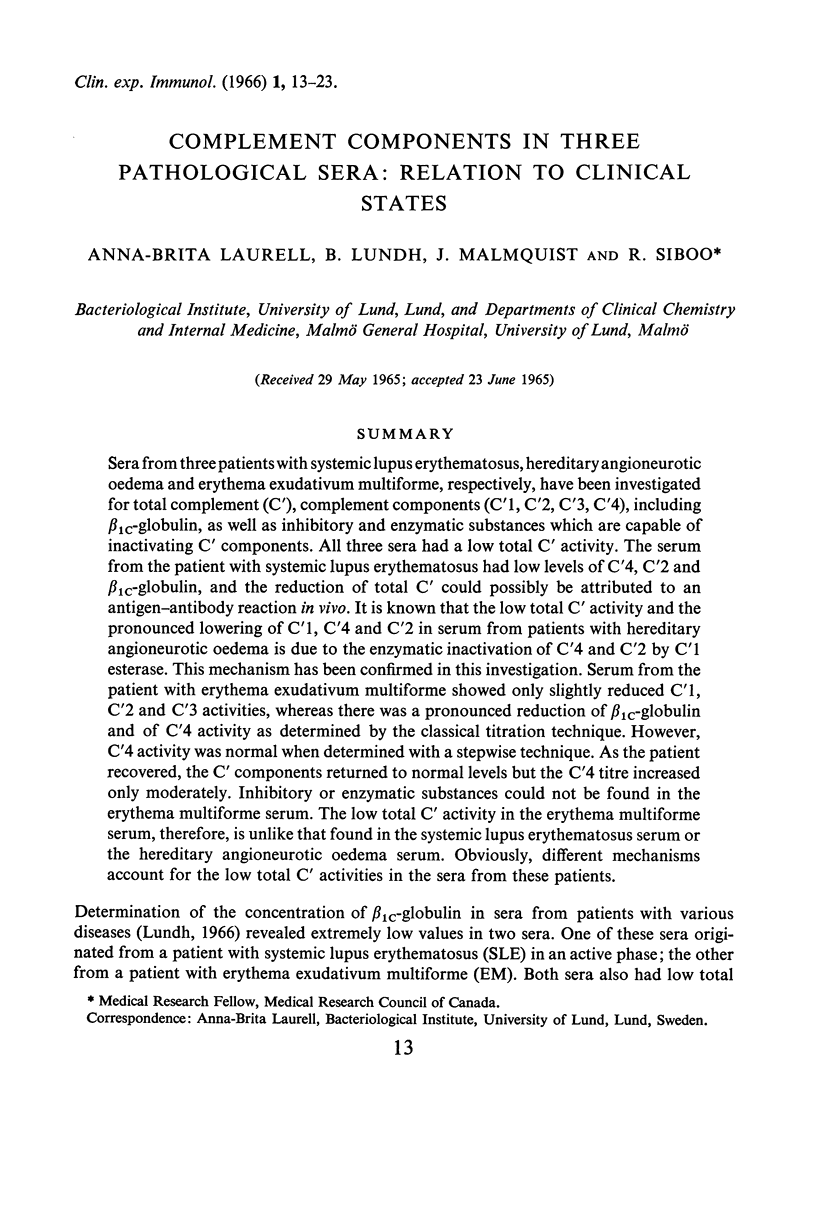
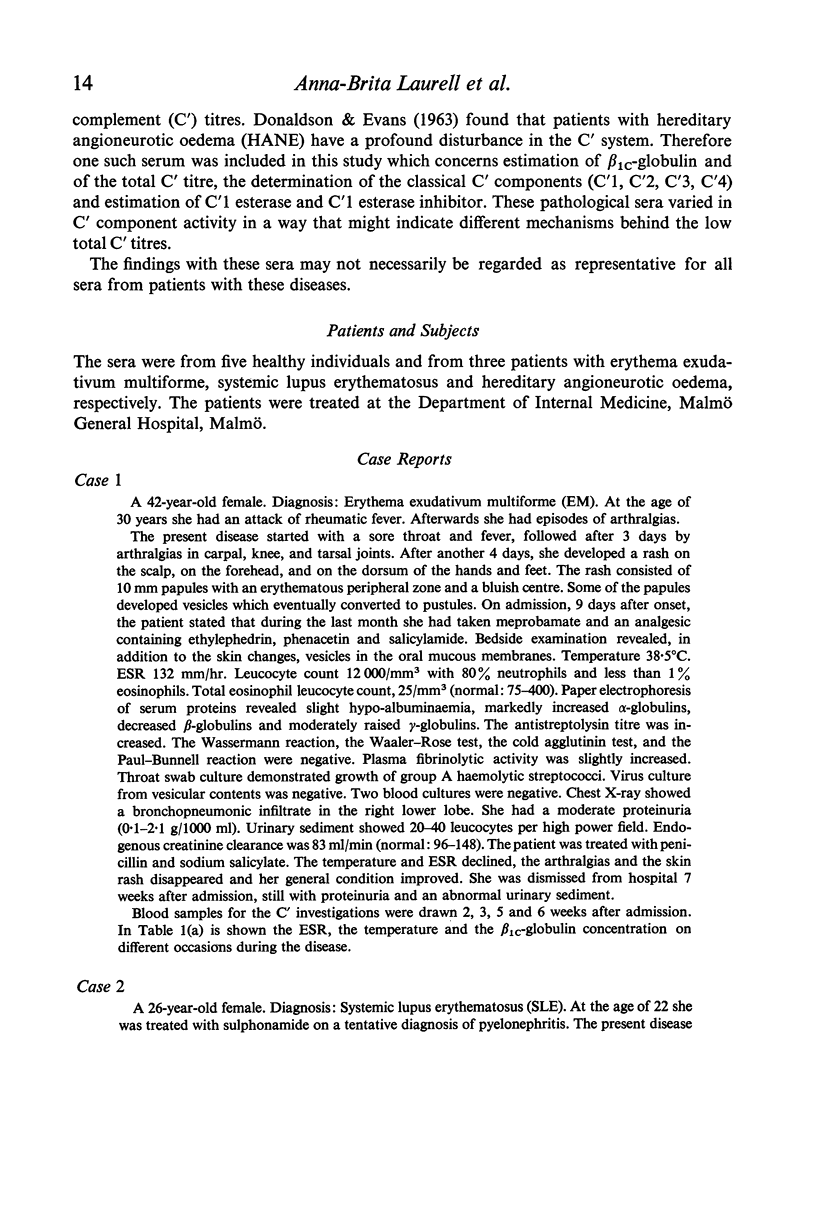
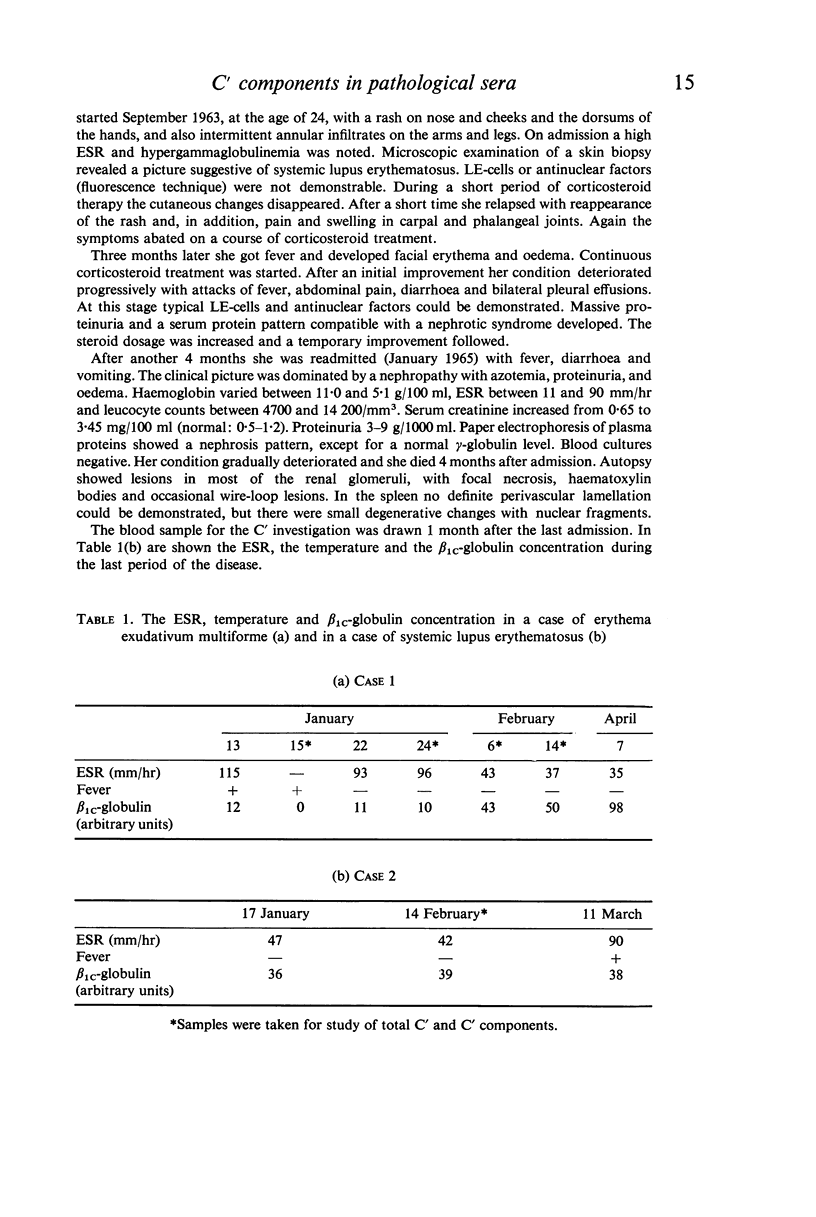
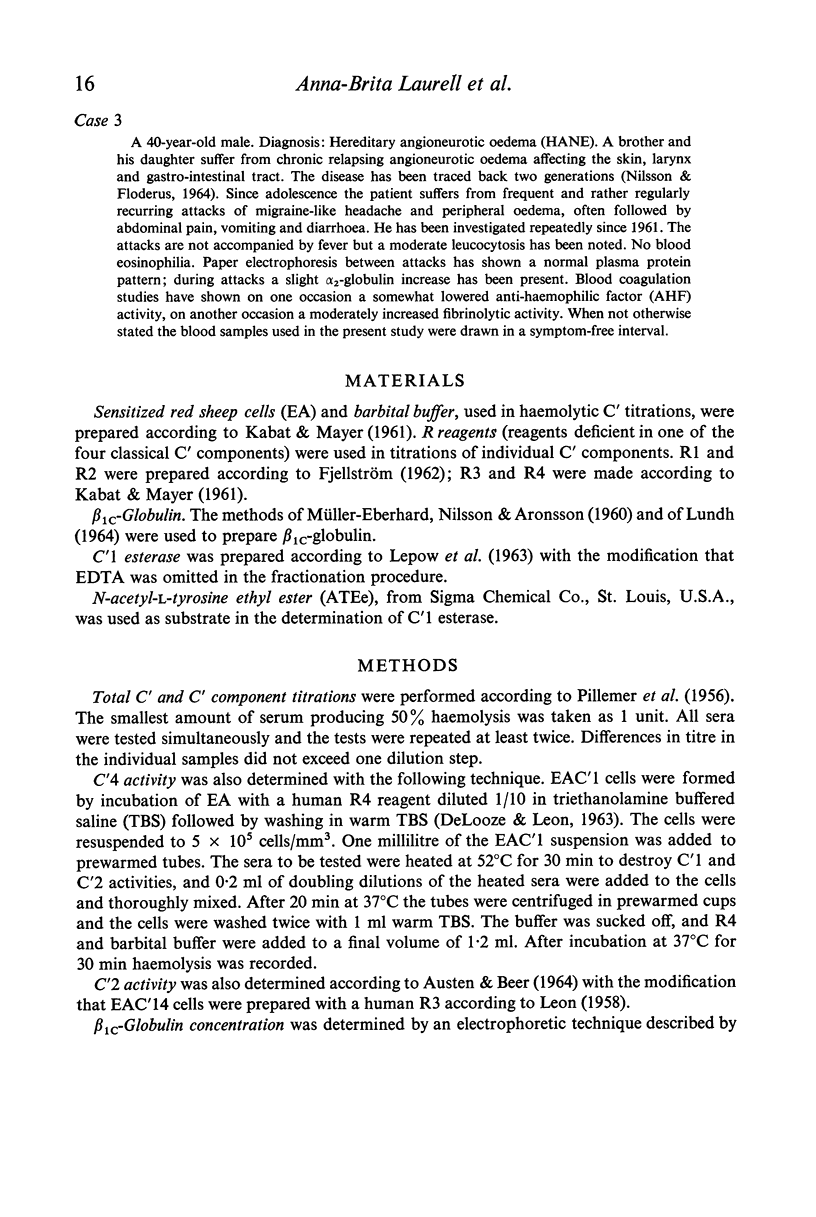
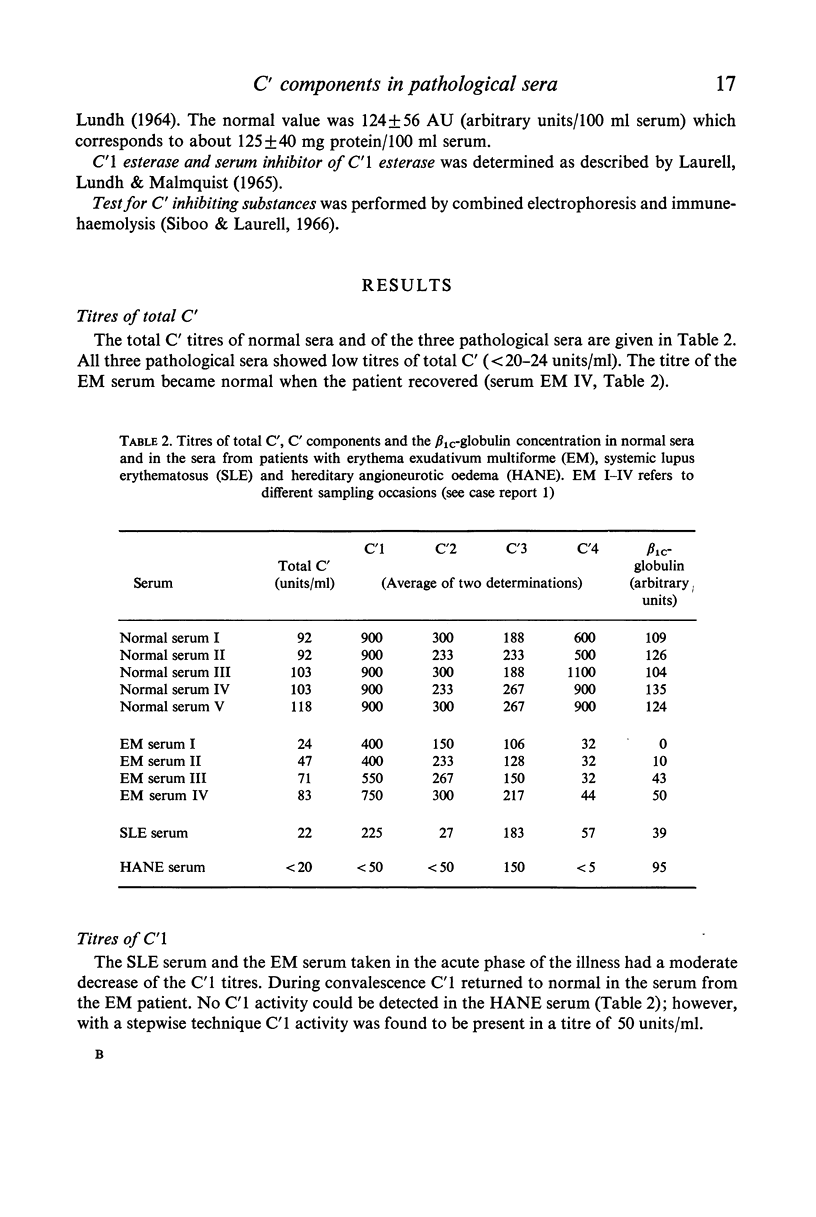
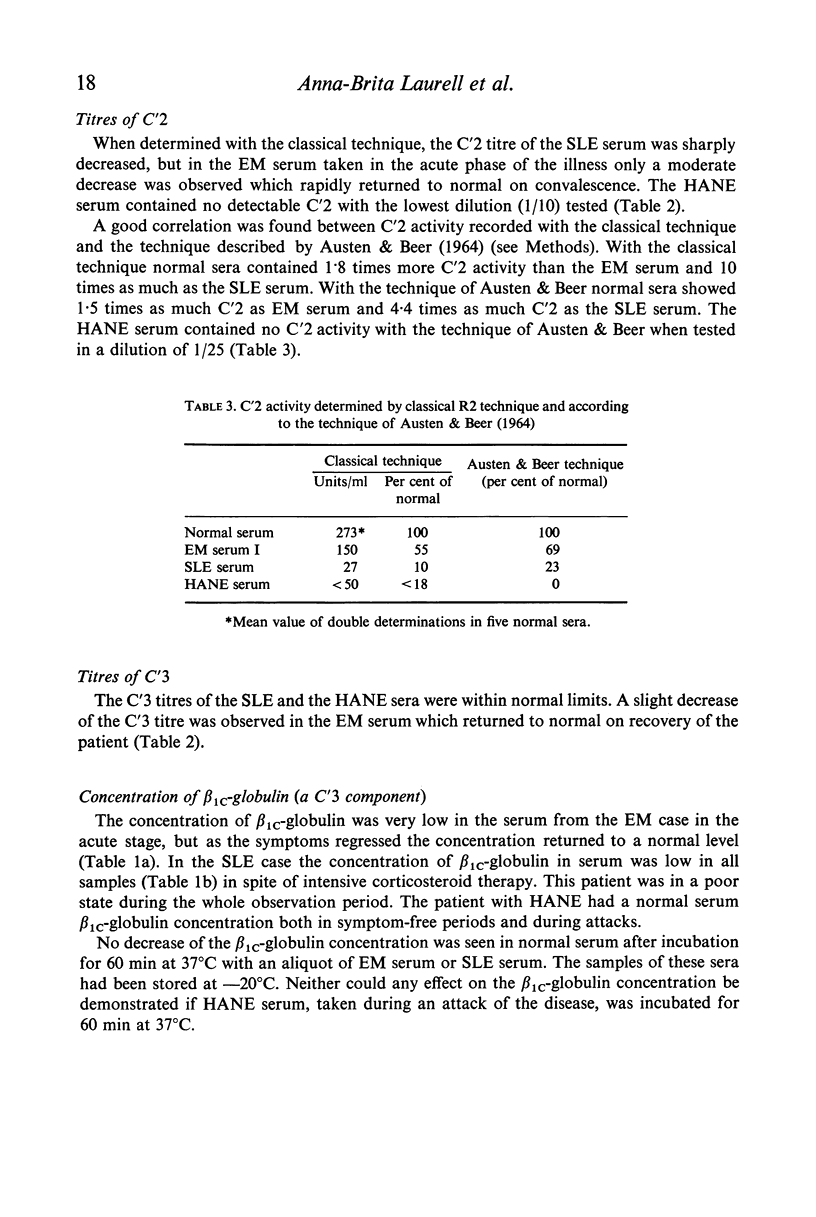
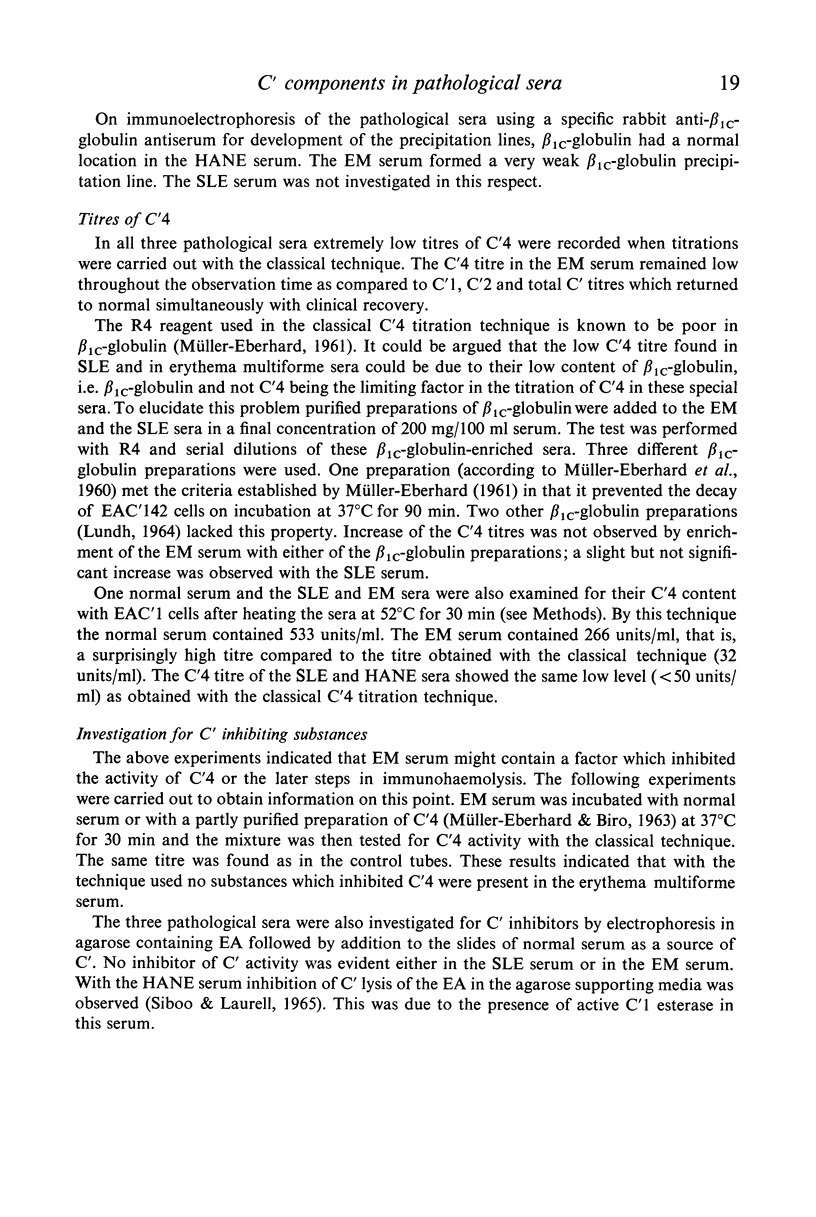
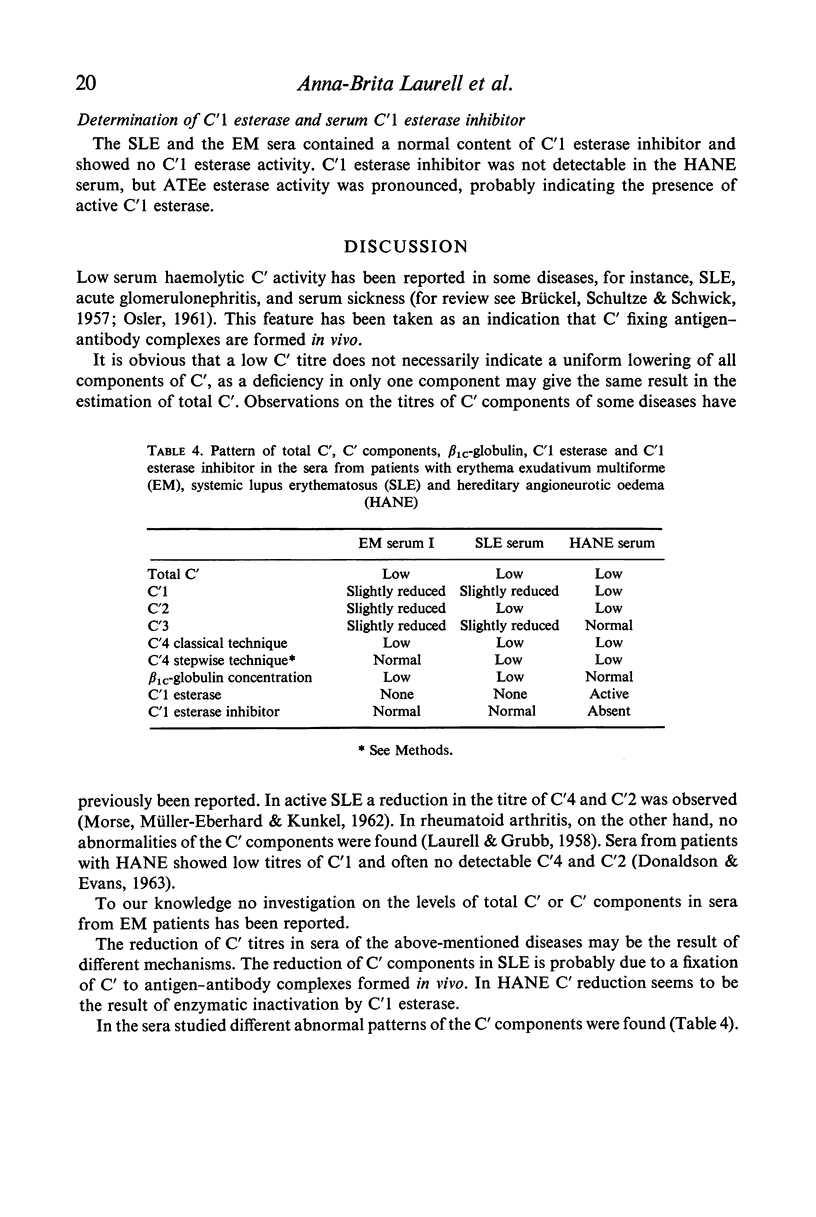
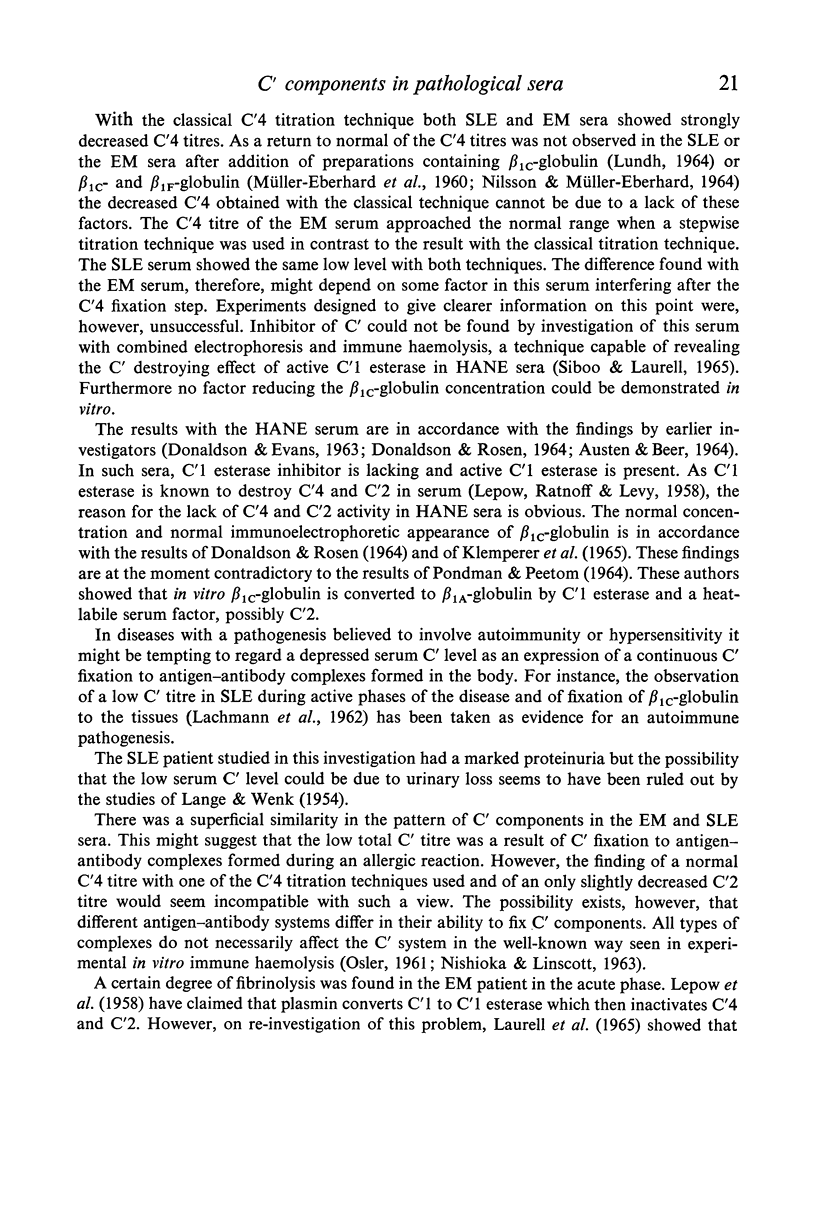
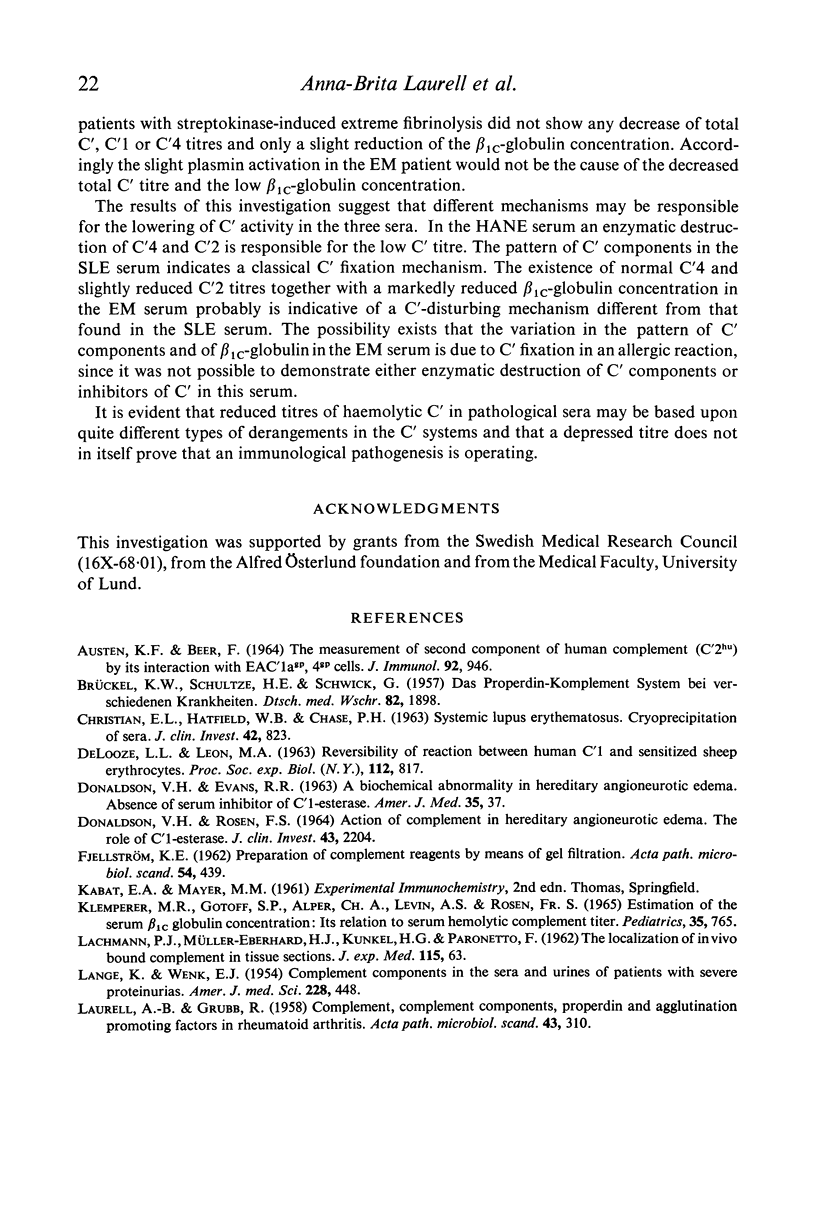
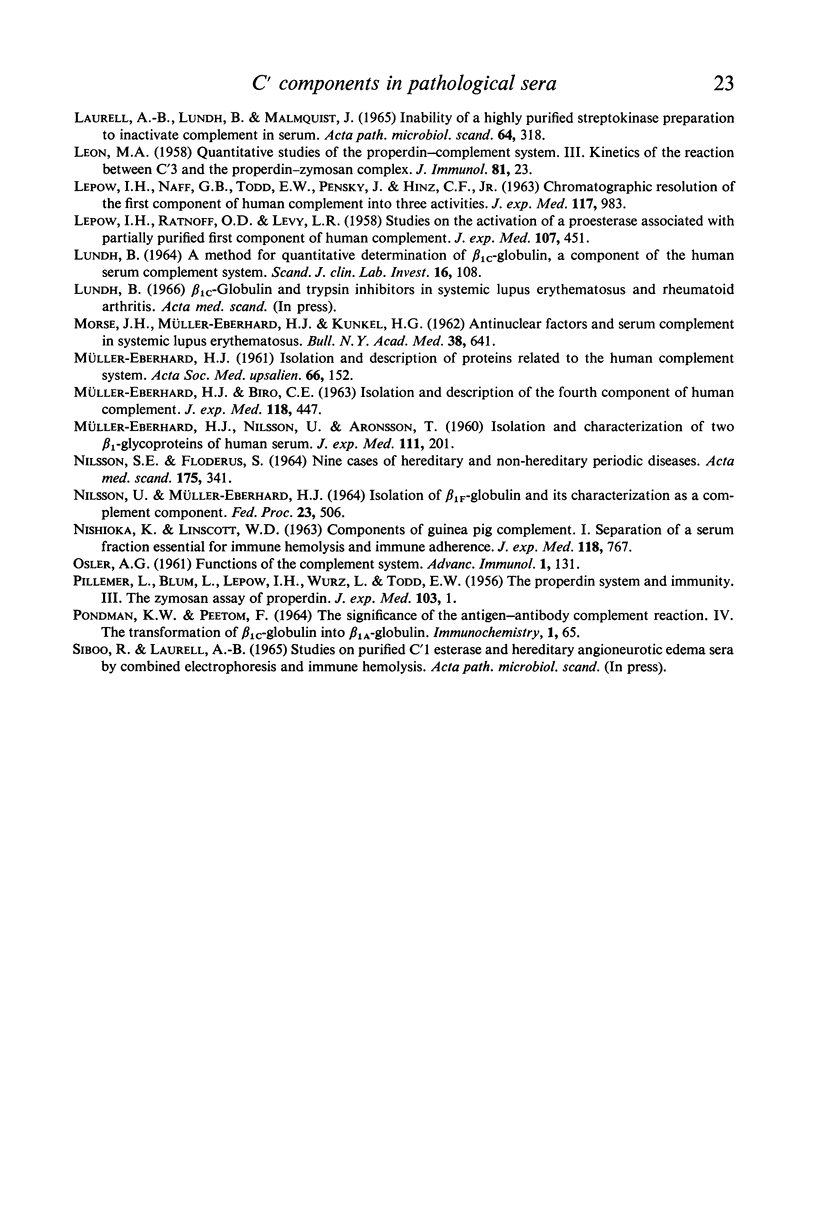
Selected References
These references are in PubMed. This may not be the complete list of references from this article.
- AUSTEN K. F., BEER F. THE MEASUREMENT OF SECOND COMPONENT OF HUMAN COMPLEMENT (C'2HU) BY ITS INTERACTION WITH EAC'1AGP,4GP CELLS. J Immunol. 1964 Jun;92:946–957. [PubMed] [Google Scholar]
- BRUCKEL K. W., SCHULTZE H. E., SCHWICK G. Das Properdin-Komplement-System bei verschiedenen Krankheiten mit Berücksichtigung der Serumproteine und Schwermetalle. Dtsch Med Wochenschr. 1957 Nov 8;82(45):1898–1903. doi: 10.1055/s-0028-1117012. [DOI] [PubMed] [Google Scholar]
- CHRISTIAN C. L., HATFIELD W. B., CHASE P. H. Systemic lupus erythematosus. Cryoprecipitation of sera. J Clin Invest. 1963 Jun;42:823–829. doi: 10.1172/JCI104774. [DOI] [PMC free article] [PubMed] [Google Scholar]
- DELOOZE L. L., LEON M. A. Reversibility of reaction between human C'1 and sensitized sheep. Proc Soc Exp Biol Med. 1963 Apr;112:817–819. doi: 10.3181/00379727-112-28177. [DOI] [PubMed] [Google Scholar]
- DONALDSON V. H., EVANS R. R. A BIOCHEMICAL ABNORMALITY IN HEREDIATRY ANGIONEUROTIC EDEMA: ABSENCE OF SERUM INHIBITOR OF C' 1-ESTERASE. Am J Med. 1963 Jul;35:37–44. doi: 10.1016/0002-9343(63)90162-1. [DOI] [PubMed] [Google Scholar]
- DONALDSON V. H., ROSEN F. S. ACTION OF COMPLEMENT IN HEREDITARY ANGIONEUROTIC EDEMA: THE ROLE OF C'1-ESTERASE. J Clin Invest. 1964 Nov;43:2204–2213. doi: 10.1172/JCI105094. [DOI] [PMC free article] [PubMed] [Google Scholar]
- FJELLSTROM K. E. Preparation of complement reagents by means of gel filtration. Acta Pathol Microbiol Scand. 1962;54:439–448. [PubMed] [Google Scholar]
- KLEMPERER M. R., GOTOFF S. P., ALPER C. A., LEVIN A. S., ROSEN F. S. ESTIMATION OF THE SERUM BETA-1C GLOBULIN CONCENTRATION: ITS RELATION TO THE SERUM HEMOLYTIC COMPLEMENT TITER. Pediatrics. 1965 May;35:765–769. [PubMed] [Google Scholar]
- LACHMANN P. J., MULLER-EBERHARD H. J., KUNKEL H. G., PARONETTO F. The localization of in vivo bound complement in tissue section. J Exp Med. 1962 Jan 1;115:63–82. doi: 10.1084/jem.115.1.63. [DOI] [PMC free article] [PubMed] [Google Scholar]
- LANGE K., WENK E. J. Complement components in the sera and urines of patients with severe proteinurias. Am J Med Sci. 1954 Oct;228(4):448–453. [PubMed] [Google Scholar]
- LAURELL A. B., GRUBB R. Complement, complement components, properdin and agglutination promoting factors in rheumatoid arthritis. Acta Pathol Microbiol Scand. 1958;43(3):310–320. doi: 10.1111/j.1699-0463.1958.tb04900.x. [DOI] [PubMed] [Google Scholar]
- LEON M. A. Quantitative studies of the properdin-complement system. III. Kinetics of the reaction between C'3 and the properdin-zymosan complex. J Immunol. 1958 Jul;81(1):23–28. [PubMed] [Google Scholar]
- LEPOW I. H., NAFF G. B., TODD E. W., PENSKY J., HINZ C. F. Chromatographic resolution of the first component of human complement into three activities. J Exp Med. 1963 Jun 1;117:983–1008. doi: 10.1084/jem.117.6.983. [DOI] [PMC free article] [PubMed] [Google Scholar]
- LEPOW I. H., RATNOFF O. D., LEVY L. R. Studies on the activation of a proesterase associated with partially purified first component of human complement. J Exp Med. 1958 Mar 1;107(3):451–474. doi: 10.1084/jem.107.3.451. [DOI] [PMC free article] [PubMed] [Google Scholar]
- LUNDH B. A METHOD FOR QUANTITATIVE DETERMINATION OF BETA-1C-GLOBULIN, A COMPONENT OF THE HUMAN SERUM COMPLEMENT SYSTEM. Scand J Clin Lab Invest. 1964;16:108–114. doi: 10.3109/00365516409060490. [DOI] [PubMed] [Google Scholar]
- Laurell A. B., Lundh B., Malmquist J. Inability of a highly purified streptokinase preparation to inactivate complement in serum. Acta Pathol Microbiol Scand. 1965;64(3):318–328. doi: 10.1111/apm.1965.64.3.318. [DOI] [PubMed] [Google Scholar]
- MORSE J. H., MULLER-EBERHARD H. J., KUNKEL H. G. Anti-nuclear factors and serum complement in systemic lupus erythematosus. Bull N Y Acad Med. 1962 Oct;38:641–651. [PMC free article] [PubMed] [Google Scholar]
- MUELLER-EBERHARD H. J., BIRO C. E. ISOLATION AND DESCRIPTION OF THE FOURTH COMPONENT OF HUMAN COMPLEMENT. J Exp Med. 1963 Sep 1;118:447–466. doi: 10.1084/jem.118.3.447. [DOI] [PMC free article] [PubMed] [Google Scholar]
- MULLER-EBERHARD H. J. Isolation and description of proteins related to the human complement system. Acta Soc Med Ups. 1961;66:152–170. [PubMed] [Google Scholar]
- MULLER-EBERHARD H. J., NILSSON U., ARONSSON T. Isolation and characterization of two beta1-glycoproteins of human serum. J Exp Med. 1960 Feb 1;111:201–215. doi: 10.1084/jem.111.2.201. [DOI] [PMC free article] [PubMed] [Google Scholar]
- NILSSON S. E., FLODERUS S. NINE CASES OF HEREDITARY AND NON-HEREDITARY PERIODIC DISEASES. Acta Med Scand. 1964 Mar;175:341–346. doi: 10.1111/j.0954-6820.1964.tb00581.x. [DOI] [PubMed] [Google Scholar]
- NISHIOKA K., LINSCOTT W. D. COMPONENTS OF GUINEA PIG COMPLEMENT. I. SEPARATION OF A SERUM FRACTION ESSENTIAL FOR IMMUNE HEMOLYSIS AND IMMUNE ADHERENCE. J Exp Med. 1963 Nov 1;118:767–793. doi: 10.1084/jem.118.5.767. [DOI] [PMC free article] [PubMed] [Google Scholar]
- PILLEMER L., BLUM L., LEPOW I. H., WURZ L., TODD E. W. The properdin system and immunity. III. The zymosan assay of properdin. J Exp Med. 1956 Jan 1;103(1):1–13. doi: 10.1084/jem.103.1.1. [DOI] [PMC free article] [PubMed] [Google Scholar]
- PONDMAN K. W., PEETOOM F. THE SIGNIFICANCE OF THE ANTIGEN-ANTIBODY COMPLEMENT REACTION. IV. THE TRANSFORMATION OF BETA-1-C-GLOBULIN INTO BETA-1-A-GLOBULIN. Immunochemistry. 1964 Jun;1:65–90. doi: 10.1016/0019-2791(64)90073-4. [DOI] [PubMed] [Google Scholar]


